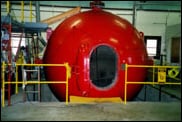Mining Topic: Blasting and Explosives
What is the health and safety problem?
Detonating explosives release toxic gases, primarily oxides of nitrogen and carbon monoxide. Nitric oxide (NO) and nitrogen dioxide (NO2) are produced by large surface blasts in which the explosive does not detonate properly. NO released by the detonation oxidizes to NO2 as the fumes mix with the atmosphere. Excessive NO2 production is apparent as an orange cloud that forms above the blasting site. NO2 is extremely toxic.
Carbon monoxide (CO) is also released by the detonation of explosives. CO is not a problem after large surface blasts because it quickly dissipates in the atmosphere to safe levels. CO dangers are more of a problem for construction, trench, and underground blasting. If a mine worker walks onto a blast site too soon after a blast, the CO emanating from the muck pile poses a serious risk to the worker. CO may also migrate hundreds of feet through the ground to collect in a homeowner’s basement, manholes, and other confined spaces.
What is the extent of the problem?

Spherical explosives testing chamber.
Following a blast, workers must wait long enough to allow the fumes to dissipate, using a portable gas monitor to ensure that the air near the blast site is safe to breathe before proceeding. Mine workers may become ill or die if they remain in an area where toxic fumes levels are high. Between 1994 and 2005, eight miners were injured by exposure to blasting fumes.
Surface blasting breaks up rock and frequently throws rock away from the blast site. Mine workers may be killed or injured by rock thrown by a blast. The blaster who designs a blast determines how far rock from the blast is expected to go. Based on this determination the blaster will designate the blast area, which is the area that must be evacuated before a blast. On occasion rock will fly further than the blaster expected. This rock is referred to as wild flyrock and may damage property and injure people on the blast site and in homes nearby. Between 1994 and 2005, 68 miners were injured because they were in the blast area during a blast and 32 miners were injured by flyrock.
How is the NIOSH Mining program addressing this problem?
The Office of Mine Safety and Health Research (OMSHR) has conducted research into the factors that increase the production of toxic gases. These factors may be explosives formulation, blasting in wet boreholes, poor confinement, or any other factor that prevents the explosive from detonating properly. This information has been published and presented at conferences so that blasters and drillers can design blasts that minimize the production of fumes. OMSHR has demonstrated that fumes from blasting may travel underground great distances and has warned mine workers and other explosives users to avoid confined spaces and carry portable instrumentation to identify the presence of toxic fumes.
What are the significant findings?
OSHMR has published “Toolbox Training” materials that inform mine workers of the importance of evacuating the blast area during a blast. OSHMR also has researched the causes of flyrock and has informed blasters how to design blasts that minimize flyrock. The “Toolbox Training” materials also increase mine workers’ awareness of this hazard.
What are the next steps?
Regulatory agencies and industry have responded to OMSHR research into the hazards of toxic gases from blasting. State and local agencies have incorporated OMSHR recommendations into regulations. Mines in Wyoming have continued to develop blasts that minimize NO and NO2. Explosives companies have developed new explosives that minimize fumes production. Companies also market products that survey the highwall at a blast site with lasers to help design blasts that minimize flyrock.
- An Analysis and Prevention of Flyrock Accidents in Surface Blasting Operations
- Behavior of Nitrogen Oxides in the Product Gases from Explosive Detonations
- Blast Area Security
- Blasting Injuries in Surface Mining with Emphasis on Flyrock and Blast Area Security
- Blasting Safety - Revisiting Site Security
- The Calculated Risk of Experiencing a Lightning Caused Unplanned Detonation
- A Century of Bureau of Mines/NIOSH Explosives Research
- Fatal Accidents Due to Flyrock and Lack of Blast Area Security and Working Practices in Mining
- Field Studies of CO Migration from Blasting
- Flyrock Issues in Blasting
- Gas and Fume Generation at the Blast Site
- A Gas Pressure-Based Drift Round Blast Design Methodology
- The Limiting Oxygen Concentration and Flammability Limits of Gases and Gas Mixtures
- Monitoring and Removal of CO in Blasting Operations
- Reconciling Longwall Gob Gas Reservoirs and Venthole Production Performances Using Multiple Rate Drawdown Well Test Analysis
- A Review of Recent Accidents Involving Explosives Transport
- A Summary of Fatal Accidents Due to Flyrock and Lack of Blast Area Security in Surface Mining, 1989 to 1999
- A Technique for Measuring Toxic Gases Produced by Blasting Agents
- Technology News 522 - Blast Area Security: Flyrock Safety
- Toolbox Training on Flyrock Awareness